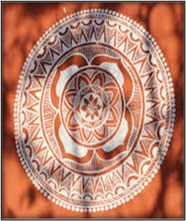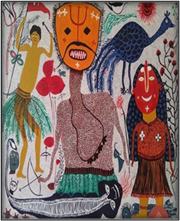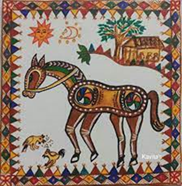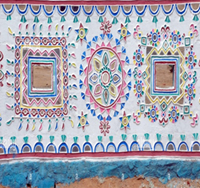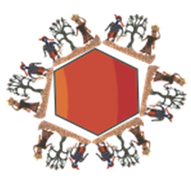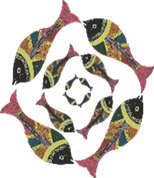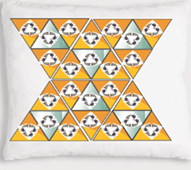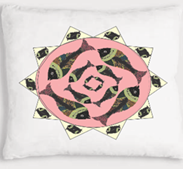ShodhKosh: Journal of Visual and Performing ArtsISSN (Online): 2582-7472
|
|
Adaptation of Tribal Art of Central Western India for development of Textile product using Digital Design Software
Anshu Singh Choudhary 1![]()
![]() ,
Dr. Deepti Pargai 2
,
Dr. Deepti Pargai 2![]()
![]()
1 Assistant
Professor, Amity University Madhya Pradesh Instead of Research Scholar, Mody
University Sikar Rajasthan, India
2 Assistant
Professor, School of Design, Mody University, Sikar Rajasthan, India
|
|
ABSTRACT |
||
|
The tribal art
of Central Western India including the Warli, Gond, Bhil, Pithora, Mandana,
and others boasts a rich heritage of vibrant colors, intricate patterns, and
traditional motifs, reflecting the unique cultural and artistic diversity of
the region. This research explores the fusion of tradition and modernity by
adapting tribal art into textile design using digital design software to
enhance the efficiency and accuracy of textile design. The study also aims to
highlight the potential for sustainable development and economic empowerment
of tribal communities while preserving and promoting their indigenous art
forms. By bridging the gap between tradition and modernity, this research
demonstrates the feasibility of adapting tribal art for textile products
using digital tools, leading to innovative and marketable designs by
preserving the art forms and improving the overall well-being of tribal
communities. |
|||
|
Received 12 October 2023 Accepted 02 December 2023 Published 13 December 2023 Corresponding Author Anshu
Singh Choudhary, anshusingh2k6@gmail.com DOI 10.29121/shodhkosh.v4.i2.2023.726 Funding: This research
received no specific grant from any funding agency in the public, commercial,
or not-for-profit sectors. Copyright: © 2023 The
Author(s). This work is licensed under a Creative Commons
Attribution 4.0 International License. With the
license CC-BY, authors retain the copyright, allowing anyone to download,
reuse, re-print, modify, distribute, and/or copy their contribution. The work
must be properly attributed to its author.
|
|||
|
Keywords: Tribal Art, Design, Digital Tool, Innovation, Style,
Creative Adaptation Etc. |
|||
1. INTRODUCTION
India's
oldest and second-largest industry is the textile sector, after agriculture.
Vedic literature contains references to the Harappa civilization's knowledge of
cotton weaving and spinning. The prosperous India textile is unique, rich and
diverse like its customs and ethnicity. Textiles are engrained in Indian
culture and ethos. All parts of the country have their own unique cultural
ethos, which is apparent in the handicrafts of that exacting region. Central
Western India is home to numerous tribal communities, each with its distinct
artistic traditions. For this study, the region for Central Western India
includes Maharashtra, Gujrat, Madhya Pradesh & Rajasthan as shown in Figure 1.
Figure 1

|
Figure 1 Map of Central Western India |
The
tribal communities of Central Western India, including but not limited to the
Warli, Bhil, Pithora, Gond, and Madhubani, have a rich and diverse cultural
heritage marked by their unique art forms. These art forms, characterized by
geometric shapes, intricate detailing, and cultural symbolism, are deeply
rooted in the history and traditions of these communities Gupta and Gangwar (2016).
In
recent years, it has become more crucial to protect and promote indigenous
creative forms. The cultural significance of tribal art, coupled with its
potential as a source of income for marginalized communities, has garnered
attention from scholars and policymakers alike Sharma (2015).
The
use of CAD tools in the textile industry has revolutionized the design and
production processes. CAD enables designers to create intricate patterns,
experiment with colors, and generate precise technical drawings, significantly
enhancing the efficiency and accuracy of textile design Senthil (2021).
The
adaptation of tribal art into textile design using CAD techniques represents a
bridge between tradition and modernity. It not only allows for the preservation
of tribal art but also offers the potential for creating innovative and
marketable textile products Sharma (2016).
Several case studies and success stories have demonstrated
the feasibility and impact of integrating tribal art into textile products
using CAD. These initiatives have contributed to the economic empowerment of
tribal communities while showcasing the artistic richness of Central Western
India YaminiJhanji
(2020).
The
adaptation of tribal art for commercial purposes raises important questions
about cultural appropriation, intellectual property rights, and ethical
considerations. Scholars have explored these challenges and emphasized the need
for responsible and ethical practices Renu et al. (2017).
Understanding
the market potential and consumer preferences for textile products featuring
tribal art is crucial for the success of such ventures. Market research and
consumer surveys have shed light on the demand for unique, culturally inspired
textile products.
Researcher
has highlighted the potential for sustainable development and community
empowerment through the adaptation of tribal art. This approach not only
generates income but also contributes to the preservation of indigenous art
forms and the overall well-being of tribal communities Nath and Shanti. (2023).
This
interdisciplinary approach has the potential to benefit both tribal communities
and the broader textile industry, fostering cultural preservation, economic
empowerment, and innovative design in a responsible and ethical manner.
1.1. Tribal Art of Central Western India
Art
is not for the possession by recognized painters, but it is an authentic mode
of expressing one's feelings. India has gifted the world some magnificent and
rare masterpieces comprise of tribal artwork which describes the cultural
beauty and diversity of the country. Indian tribal art has a distinct position
among all the art forms. It is a class apart, well respected and admired by
everyone. This art helps the viewers to feel the lives and lifestyle of the
Indian tribes. This art has positivity in its various themes and ideas like
life, marriage, birth, harvest, jubilation, etc.
1.2. Tribal Art of Madhya Pradesh
While
the majority of Madhya Pradesh is in Central India, its western part is often
included in the Central Western region. Due to its geographic location in the
middle of India, Madhya Pradesh is regarded as the "Heart of India"
and is renowned for its amazing culture. Despite significant cultural overlap
with states like Rajasthan and Maharashtra, the state nonetheless maintains a
distinctive culture all its own. Numerous indigenous settlements can be found
in this area. The tribal paintings portray the way of life in areas like
Chhattisgarh, Bundelkhand, Malwa, Gondwa, and Nimar. Jabalpur and Tikamgarh
famous for statues of humans’ structures and animals Saxena (2017). These arts and crafts are
well-maintained by the locals.
1) Bhil
Art: The Bhil tribe is India's second-largest tribal group. In addition,
they produce bhil art. This artform is found in Madhya Pradesh, Rajasthan,
Gujarat, and Maharashtra. The life of Bhils is revealed via this painting. To
describe life in vivid hues, this tribe employed dots, as seen in Figure 2a. They try to connect their art and paintings with their Gods,
Goddesses and nature. This includes carving of the Sun, Moon, nature, Gods,
etc. from natural and herbal colours on walls or paper Khot
(2021). One can easily
understand the story behind the painting.
2) Gond
Art: This art, which is carved on mud walls, comes from the state of Madhya
Pradesh and neighbouring states. These paintings are full of interesting
details, lines, colours, and humour. These paintings are also drawn on paper,
canvas, cloths etc Bora
and Sarma (2017). In these paintings,
lines, dots and dashes are important features as shown in Figure 2b. These paintings are drawn during major festivals such as
Holi, Diwali, etc.
3) Bagh Print: The Bagh print is a traditional
hand-block printing technique practiced by the Adivasi (tribal) communities in
Dhar district, Madhya Pradesh. Bagh prints are characterized by bold,
repetitive geometric patterns and motifs as shown in Figure 2c. They are primarily used in creating colorful and
intricately designed textiles, including sarees, dupattas, and bedspreads.
4) Dhokra Art: Dhokra is an ancient form of
metal casting practiced by tribal communities in Madhya Pradesh. It involves
using the lost wax casting technique to create intricate metal artifacts,
including figurines, jewelry, and home decor items as shown in Figure 2d.
Figure 2
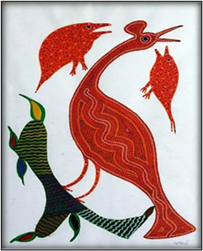
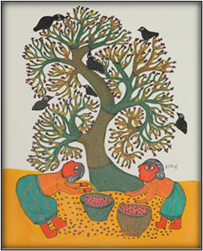
a) Bhil Art
b) Gond Art
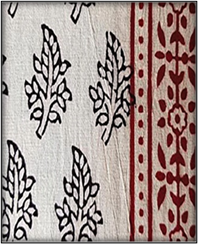

c) Bagh Print d) Dhokra Art
|
Figure 2 Tribal Art of Madhya Pradesh |
1.3. Tribal Art of Rajasthan
Some
parts of western Rajasthan, particularly the areas bordering Gujarat and Madhya
Pradesh, may also be considered part of Central Western India. Rajasthan's
western region is renowned for its traditional textile craft, which uses a
combination of textiles including cotton, silk, and wool to create stunning
patterns and textures in a variety of brilliant hues.
It is
well known that Rajasthan is a rich source of art, culture and craft; however,
many ancient crafts and techniques related to textiles are facing challenges
for their existence. Many of them are almost obsolete due to their
time-consuming process of manufacturing and higher cost in the competitive
market. It becomes necessary to preserve as well as promote this traditional
heritage craft and make aware the people about the unique features of this
printing technique Nath and Shanti. (2023).
In West Rajasthan,
particularly in regions bordering Gujarat and Madhya Pradesh, you can find
various tribal art forms. Here are some of the prominent tribal art forms of
West Rajasthan
1) Mandana
Painting: Since the "Meenas," a Scheduled Tribe in Rajasthan,
predominately practise it, it is also known as "Meena Painting." The
majority of this art's creators are women, who paint almost every surface in
the home that needs to be made more attractive, as seen in Figure 3a. The Bhil and Shrimali Brahaman communities also practise
mandalas, although their colour schemes and design elements are substantially
different from those used by Meenas. This artform is still
widespread in Alwar, Bharatpur, Bundi Jaipur, Sawai Madhopur, and
Tonk districts of Rajasthan. This artwork is referred to as
"Mandala" in Nepal. In Rajasthan, it is done on both the walls and
the floors, in contrast to Madhya Pradesh where it is limited to the flooring.
Mandana are drawn to protect home and household from evil and welcome
Gods into the house and as a mark of celebrations on festive occasions Quazi
(2017). This art is often
passed down through generations from mother/other elder females to daughters.
2) Gavari
Art: Gavari is a religious festival celebrated by the Bhil and Meena tribes
in Rajasthan. During this festival, intricate and colorful Gavari paintings are
created on the walls of homes and temples. It is predominantly a narrative art
form. Artisans are referred as "Bhopas" or "Bhopis," who
are responsible for creating intricate paintings or murals that depict various
episodes from the life of Lord Shiva and other deities. Gavari paintings often
depict mythological scenes, deities, and stories related to the festival with
usage of bold & bright colours as shown in Figure 3b.
3) Garasia Art: The Garasia tribes in Rajasthan are known for their Gotrej Painting. The Garasias are expert in line and graphic drawing as shown in Figure 3c. The drawing, relief, and tattoo arts may be used to classify their painting heritage. During the marriage ceremony, gotrej, or clan deities like Jaru Mata, Alu Mata, Amba Mata, etc., are painted. In addition to painting, people often decorate floors and walls at weddings and other important holidays like Holi, Deepavali, Gangour, Navaratri, etc.
Figure 3
|
a) Mandana Art |
b) Gavari Art |
c) Garasia Art |
|
Figure 3 Tribal Art of Rajasthan |
1.4. Tribal Art of Maharashtra
This state covers a significant portion of Central Western India and is known for its rich cultural diversity, including various tribal communities like Warli, Gondhal, Thakar, Andh, etc.
1) Warli Art: The Warli tribe, primarily located in the Thane district of Maharashtra, is known for its distinctive Warli art. As shown in fig 4, this art form features intricate geometric patterns, typically painted with white pigment on mud walls, representing scenes of daily life, nature, and rituals Rao (2022).
Figure 4

|
Figure 4 Tribal Art of Maharashtra |
1.5. Tribal Art of Gujrat
Located
to the northwest of Maharashtra, Gujarat is another key state in Central
Western India with a diverse cultural heritage and a significant tribal
population. It is home to several tribal communities, each with its unique art
forms and cultural expressions. The tribal art of Gujarat is characterized by
its vibrant colors, intricate patterns, and close ties to nature and
spirituality. Here are some prominent tribal art forms of Gujarat.
Pithora Art: This art practiced among the Rathwa and Bhil tribes in Gujrat. The vibrant & colourful pithora painting are more than just beautiful figures and patterns which have enormous religious significance, and their construction entails a full ritual including music and dancing. These paintings as shown in Figure 5a typically feature depictions of deities, animals, humans, and symbols representing various aspects of tribal life and spirituality Gandhi. (2013). The Pithora deity, a central figure in these paintings, is believed to protect the community and ensure its well-being. Pithora paintings are known for their vibrant and colorful compositions. They often use a limited palette of bright hues, including red, yellow, blue, and green.
Mud and Mirror Work: In the Kutch region of Gujarat, tribal communities like the Rabari and Ahir are renowned for their intricate mud and mirror work as shown in Figure 5b. This craft involves decorating textiles, such as clothing and home furnishings, with tiny pieces of mirror and colorful work.
Rogan Art: Rogan art is a traditional form of fabric painting practiced by the Khatris, a nomadic tribe found in both Gujarat and Rajasthan. This art form involves creating intricate, freehand patterns using castor oil-based paints. Rogan art uses specially prepared paints created by heating castor oil until it becomes viscous and dense. Pigments derived from natural sources are then mixed with the castor oil to create a range of colors Shwetha (2017). The artist uses a metal rod or stylus, known as "Rogan pen," to apply the paint to the fabric. The design is created directly on the fabric without any prior sketching or tracing. Rogan art is known for its intricate and complex patterns. These patterns often include floral motifs, geometric designs, peacocks, and other elements inspired by nature and tribal culture as shown in Figure 5c.
Figure 5
|
a) Pithora Art |
b) Mud or Mirror Work |
c) Rogan Art |
|
Figure 5 Tribal Art of Gujrat |
The
main purpose of this paper is to analyse the rich heritage of tribal art in
Central Western India and to explore the potential of tribal art as a source of
income and cultural preservation. This paper also emphasis to develop some
designs by using digital tool such as Corel draw and to integrate the developed
design into textile Product.
2. Methodology
As
the study is multi-disciplinary in nature, an exploratory research design is
employed. This allows for a flexible and open-ended approach for data
collection and analysis. As mentioned previously, an extensive literature
review is conducted to understand the existing research related to tribal art,
digital tool in textile design, and the integration of the two. The present
study is aimed to collect the information about the tribal art of Central
Western India and their adaptation on textile through computer aided design.
Bhil Tribal art practiced by Bhil community of Madhya Pradesh is selected by
using purposive sampling. Data was collected from both primary and secondary
sources. Interview, observation and key informant, focused group discussion
were also the methods employed for data collection.
Primary
data collection method is used to gather data. Various Interviews and surveys
were conducted in tribal communities to gather insights into their traditional
art forms, techniques, and economic needs. Bhil Art designs were collected from
various sources like Tribal Museums, Magazine, books, photographs, and
stickers. Fifteen motifs were selected after seeing the possibility of
transforming motifs and design into other designing technique without
disturbing the original colour & motif. Out of fifteen motifs collected,
five motifs were selected by experts for further development of designs.
Selected
tribal art motifs and patterns are adapted and modified using digital tools to
create textile designs. During the process, neither the colours were changed
nor the originality of the motifs to respect the cultural and artistic
integrity of the original art forms. Textile prototypes featuring
adapted tribal art are created using heat transfer printing. These prototypes
serve as visual representations of the adapted designs. Expert review is
taken for the adapted textile design to evaluate their authenticity, aesthetic
appeal, and cultural sensitivity.
3. Result AND Discussion
The motifs were evaluated by 50 respondents selected randomly which include PG students & faculty members of Design Department in the age group of 20-35. To gather data, a structured interview schedule and a five-point Likert scale have been developed. For each motif, a Weighted Mean Score (WMS) was calculated. The motif which scores highest weighted mean score was assigned rank I. Preferred choice for selection of Bhil tribal motif is depicted in Figure 6 and Table 1. It is evident that motif no 6 got 1st rank with weighted mean score of 4.12, followed by motif no 1 which was ranked 2nd rank with weighted mean score of 4.10 and 3rd rank with Weighted mean score of 4.02 was motif no 9. The other motifs in descending order are 15(3.68), 12(3.64), 13(3.60),2(3.56),4(3.54), 8(3.44), 11(3.42), 10(3.40), 5(3.38), 3(3.22), 14(2.88) and the least preferred motif was motif no 07 with WMS of 2.70 at rank no 15.
Figure 6
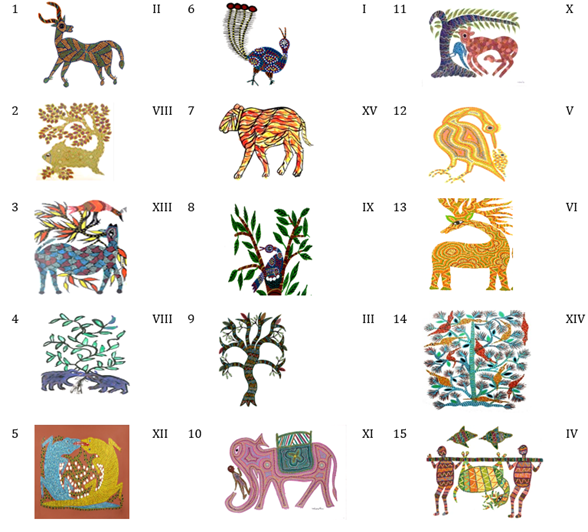
|
Figure 6 Collected Motifs of Bhil Art of Madhya Pradesh |
Selected motifs were used on Cushion covers for further adaptation, yet other different textile product like table cover, bag, curtains, file cover etc. can also be adapted. The prepared article was then evaluated to access their acceptability & colour combinations and overall appearance using weighted mean score.
Table 1
|
Table 1 Experts Preferences for Selection of
Motifs of Bhil Tribal Art |
|||
|
Sr No |
Motif No |
WMS |
Rank Order |
|
1 |
1 |
4.10 |
2 |
|
2 |
2 |
3.56 |
7 |
|
3 |
3 |
3.22 |
13 |
|
4 |
4 |
3.54 |
8 |
|
5 |
5 |
3.38 |
12 |
|
6 |
6 |
4.12 |
1 |
|
7 |
7 |
2.70 |
15 |
|
8 |
8 |
3.44 |
9 |
|
9 |
9 |
4.02 |
3 |
|
10 |
10 |
3.40 |
11 |
|
11 |
11 |
3.42 |
10 |
|
12 |
12 |
3.64 |
5 |
|
13 |
13 |
3.60 |
6 |
|
14 |
14 |
2.88 |
14 |
|
15 |
15 |
3.68 |
4 |
Top
five motifs were selected i.e motif no 6,1, 9,15 and 12 according to experts’
choice for further work based on their weighted mean score.
2.1. Development of design for Bhil tribal art from selected motifs
Figure 7
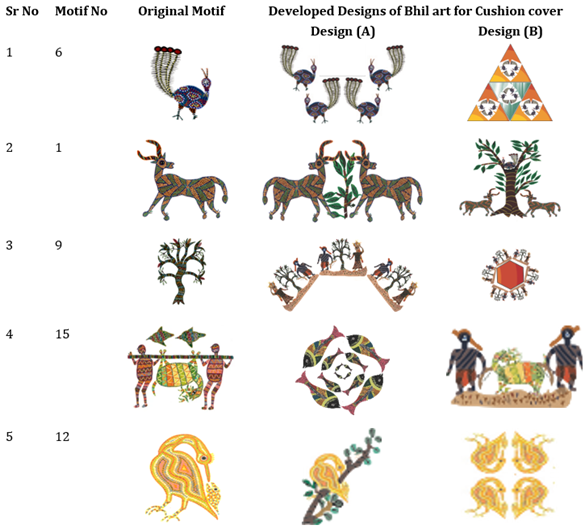
|
Figure 7 Developed Designs of Bhil Art for Cushion Cover |
Two designs were developed from each selected
motif of Bhil art which were named as A & B. A total of ten motifs were
developed using vector based digital tool like Corel draw and are presented in Figure 7 for cushion cover. These
prepared design arrangements were also evaluated by a panel of 50 respondents
selected randomly. Weighted mean score was calculated for each design
arrangements.
Table 2
|
Table
2 Experts Preferences for Developed
Designs of Bhil Art for Cushion Cover |
|||||
|
Sr No |
Motif No |
WMS (A) |
Rank (A) |
WMS (B) |
Rank (B) |
|
1 |
6 |
3.08 |
X |
3.88 |
I |
|
2 |
1 |
3.1 |
IX |
3.3 |
VIII |
|
3 |
9 |
3.54 |
IV |
3.6 |
II |
|
4 |
15 |
3.56 |
III |
3.48 |
V |
|
5 |
12 |
3.42 |
VI |
3.32 |
VII |
Preferred choice for selection of developed designs out of 5 base motifs of Bhil art for cushion cover is depicted in Table 2. Motif No 6 (B) got 1st rank with weighted mean score of 3.88 followed by motif no 9(B) which got rank II with WMS of 3.6 and the 3rd rank was achieved by motif no 15(A) with WMS of 3.56. The other motifs in descending order are 9A (3.54), 15B (3.48), 12A (3.42), 12B (3.32), 1B (3.3), 1A (3.1) and the least preferred motif was motif no 6A with WMS of 3.08 at rank no 10. Top three selected designs for printing on cushion cover are motif no 6B, 9B and 15A as shown in Figure 8.
Figure 8
|
Motif No 6B |
Motif No 9B |
Motif No 15A |
|
Figure 8 Selected Top Three Designs of Bhil Art for Cushion cover |
Finally,
the top three selected motifs of Bhil art are printed on a 16/16 cushion cover using
heat transfer printing Machine. The peacock design (6B) was used in centre of
cushion with mirror & brick repeat to form an attractive design. The human
design (9B) was also adapted with straight diagonal repeat. The fish design (15 A) was adapted in centre of
cushion cover along with geometric patterns for border design using heat
transfer printing technique on cushion cover as shown in Figure 9.
Figure 9
|
Design 1
using Motif No 6B |
Design 2
using Motif No 9B |
Design 3
using Motif No 15A |
|
Figure 9 Placement of Selected Motif on Cushion Cover |
These
design placement of cushion cover were also evaluated by a panel of 50
respondents. Weighted mean score was calculated for each design arrangements as
shown in Figure 9 and Table 3.
Table 3
|
Table 3 Experts
Preferences for Placement of Designs of Bhil Art on Cushion Cover |
|||
|
Sr No |
Design No |
WMS |
Rank Order |
|
1 |
1 |
3.7 |
1 |
|
2 |
2 |
3.34 |
2 |
|
3 |
3 |
2.92 |
3 |
As
it can be seen from Table 3 that the among the three designs
prepared for cushion cover, design 1 is the most preferred article design by
respondents with respect to the overall appeal with weighted mean score of 3.7
The second preferred design was Design 2 with weighted mean score of 3.34 and
the least preferred design was Design 3 with weighted mean score of 2.92.
4. Conclusion
The adaptation of tribal art
from Central Western India for the development of textile products digital
tools represents a harmonious fusion of tradition and technology, with immense
potential for cultural preservation and economic development. This endeavour
has not only enabled the preservation of rich indigenous art forms but has also
opened new avenues for sustainable livelihoods and economic growth for tribal
communities.
Variety
of creative designs can be created by using digital tool like Corel draw which
will add creativity and make the process more efficient. The motifs explored
for Bhil art were highly acceptable for cushion covers and can also be printed
on other textile articles.
CONFLICT OF INTERESTS
None.
ACKNOWLEDGMENTS
None.
REFERENCES
Anjali Khot. (2021). The Creative Tribal Bhil Art of India – Need To Be Focus. International Journal of Textile and Fashion Technology (IJTFT), 11(2), 1–8.
Bora, S., and Sarma, S. (2017). Designing of Apparel Using Traditional Gond Painting Motif. International Journal of Home Science, 3(1), 304–309.
Gupta, M., and Gangwar, S. (2016). Adaptation of Designs for Textile Products Inspired from Madhubani Painting. International Journal of Research -Granthaalayah, 4(5). https://doi.org/10.29121/granthaalayah.v4.i5.2016.2687
Nath, P. P., and Shanti. (2023). Aesthetics and Visual Connotations of Rajasthani Folk Arts: A Critical Study. ShodhKosh: Journal of Visual and Performing Arts, 4(1). https://doi.org/10.29121/shodhkosh.v4.i1.2023.266
Poonam Gandhi. (2013). Tribal Art and Development: An Exploration of Pithora Art of Gujarat. GRA - Global Research Analysis, II(II).
Quazi, A. H. (2017). Dying Mandana Art Still a
Part of Diwali Festivities in Rajasthan.
Rao, K. M. (2022). Warli Painting: Aesthetics of Indigenous Art Form of India. ShodhKosh: Journal of Visual and Performing Arts.
Renu, Arya, N., Chauhan, N., & Sodhi, S. (2017). Adaptation of Kasuti Embroidery Motifs for Hand Painted Textile Articles. International Journal of Current Microbiology and Applied Sciences, 6(12), 73–80. https://doi.org/10.20546/ijcmas.2017.612.009
Saxena, A. (2017). An Account of Dots And Lines – The Gond Tribal Art of Madhya Pradesh, Their Tradition, Relevance and Sustainability in Contemporary Design Domain. Indian Journal of Current Research, 61128–61135.
Senthil Vel. (2021). 52 Incredible Indian Folk Art Forms That We Must Protect in Indian Art and Culture. Medium.
Sharma, E. (2015). Tribal Folk Arts of India Ekta Sharma. Journal of International Academic.
Sharma, E. (2016). Digitalization of Motifs Based on Indian Folk Paintings Through CAD and their Adaptation on Apparels using Digital Printing Technique. Research Journal of Family, Community and Consumer Sciences, 4(1).
Shwetha, R. G. (2017). Revival and
Application of Rogan Painting on Waterproof Reversible Denim Jackets.
International Journal of Creative Research Thoughts, 5(4), 1890–1905.
YaminiJhanji, D. (2020). CAD
intervention for Revival, Stylization & Adaptation of Madhubani Traditional
Textiles. International Journal for Modern Trends in Science and Technology,
6(8S). https://doi.org/10.46501/ijmtstciet28
|
|
 This work is licensed under a: Creative Commons Attribution 4.0 International License
This work is licensed under a: Creative Commons Attribution 4.0 International License
© ShodhKosh 2023. All Rights Reserved.


